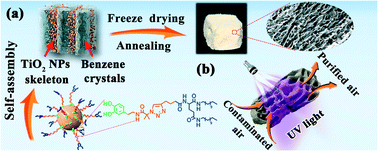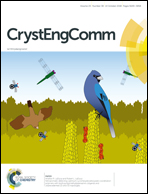Preparation of crystal TiO2 foam with micron channels and mesopores by a freeze-casting method without additives and unidirectional freezing†
Abstract
TiO2 monoliths with hierarchical pores and three-dimensional (3-D) networks have attracted much interest due to their potential applications in photocatalysis, photovoltaic and electrical energy storage, etc. However, their present preparation procedures are complex and expensive. Herein, we report a novel, simple, scalable and low-cost strategy based on the self-assembly of a ligand attached to TiO2 nanoparticles (NPs) to prepare crystal TiO2 foam with micron channels and mesopores in its 3-D skeleton, which has been fabricated via centrifugation and subsequent freeze-drying of suspensions of TiO2 particles in benzene. Furthermore, FT-IR and SEM measurements demonstrated that the 3-D continuous skeleton and channels are formed in a synergistic way, which were facilitated by hydrogen bonding between ligands, and the size of these can be regulated by varying the centrifugal speed. The produced TiO2 foam acts as a good photocatalyst for the degradation of formaldehyde due to its good mass transport through the micron channels. This work provides a novel strategy for the synthesis of the hierarchical porous crystal TiO2 foam by ligand self-assembly and it would be widely used in preparing other crystal porous functional materials.



 Please wait while we load your content...
Please wait while we load your content...